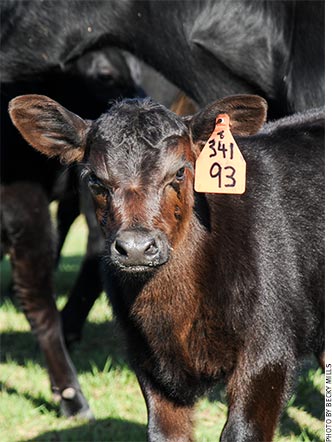Preventing Enterotoxemia
in Young Calves
Vaccinate with a seven- or eight-way clostridial vaccine to avoid problems, says CSU veterinarian.
 “The best way to prevent acute toxic gut infections in young calves caused by Clostridium perfringens is to vaccinate the dam,” says Robert Callan, chief of staff at the large animal hospital at the Colorado State University (CSU) James L. Voss Veterinary Teaching Hospital. “Then the antibodies will be in the GI (gastrointestinal) tract as soon as the newborn calf nurses, to neutralize the toxin. When we vaccinate calves at birth, it takes 10 to 14 days to develop peak antibody levels and strong immunity, and maybe longer, since two doses of vaccine are often necessary,” he says. Vaccinating the calves can be beneficial, however, in herds that experience the worst problems in older calves.
“The best way to prevent acute toxic gut infections in young calves caused by Clostridium perfringens is to vaccinate the dam,” says Robert Callan, chief of staff at the large animal hospital at the Colorado State University (CSU) James L. Voss Veterinary Teaching Hospital. “Then the antibodies will be in the GI (gastrointestinal) tract as soon as the newborn calf nurses, to neutralize the toxin. When we vaccinate calves at birth, it takes 10 to 14 days to develop peak antibody levels and strong immunity, and maybe longer, since two doses of vaccine are often necessary,” he says. Vaccinating the calves can be beneficial, however, in herds that experience the worst problems in older calves.
The C. perfringens type C and D antitoxin can also be helpful, especially in young calves born to dams that have not been vaccinated, he says. Some ranchers routinely give antitoxin at birth to calves if they know the dam was not vaccinated, or if they purchased the cow and don’t know her vaccination history. They may also give antitoxin to any calf that develops symptoms of disease — if they can find the calf before it dies.
The vaccines (toxoids) are very effective — especially against C. perfringens types C and D, he says. Herds vaccinated with an eight-way clostridial vaccine (for blackleg, malignant edema, “redwater,” type C & D, etc.) rarely experience these problems.
He notes that he still sees herds with calves dying from enterotoxemia, a disease people refer to as “purple gut disease.” Signs of illness are the same, but the eight-way vaccine and C and D toxoid are less effective at preventing this one.
“When we look at these diseases in beef calves today, probably the majority are now caused by C. perfringens type A. When we culture intestinal contents of beef calves with signs of enterotoxemia, there is often very high growth of C. perfringens type A and not C or D,” says Callan.
The illness appears rapidly. One minute the calf is healthy and feeling good, nursing its dam and acting normally, then suddenly it develops gut pain. Usually the cow is nursed out. This is different from most cases of scours in which the calf is off feed and dull before it actually breaks with diarrhea.
The typical clostridial gut infection has sudden onset. The calf may have a distended belly and feel miserable, or may just have gut pain. It may run wildly, trying to get away from the pain, then throw itself to the ground to kick and thrash like a colicky horse. It may get up and down repeatedly, staggering around. Before long, however, it can no longer get up, because it goes into shock. If this condition is not reversed quickly, the calf slips into a coma and dies, Callan explains.
All cattle should be routinely vaccinated against clostridial diseases with a seven- or eight-way product that includes types C and D, Callan advises. Cows should be vaccinated before calving, and calves vaccinated at about a month of age. If a herd is still experiencing problems, there is another vaccine for Type A.
“Novartis produces a C. perfringens toxoid for Type A, under a conditional license. It should be given to the dam before calving to provide antibodies in her colostrum to protect the calf,” Callan says. If cases are occurring in calves older than a month of age, the calves themselves should be vaccinated.
Callan says more and more veterinarians are now using Type A vaccine and seeing improvements in calves. If a producer is having problems in calves 10 days to three months of age, in spite of diligent vaccination against C. perfringens Types C and D, this vaccine is worth trying.
Some cases are caused by type E, however, for which there is no vaccine. Producers can use autogenous products, created from cultures taken from their own cattle. Veterinarians have done pathology work on calves that died, finding different genotypes, and then had an autogenous vaccine created against that specific type. Some producers have had good luck with that approach. There are various labs around the country that will take the cultures and generate their own vaccine for that specific organism at a reasonable cost.

Editor’s Note: Heather Smith Thomas is a cattlewoman and freelance writer from Salmon, Idaho.






